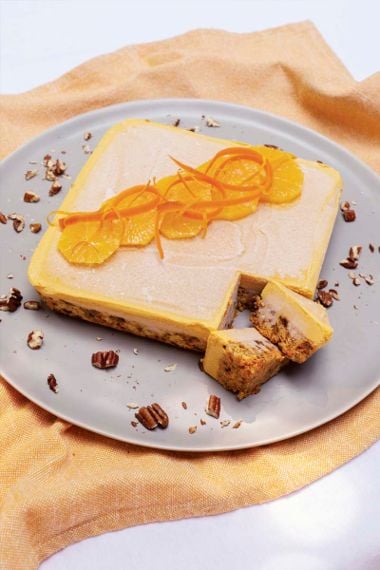
What better way to celebrate healthy eating than with cake? Thanks to a healthy dose of orange fruits and vegetables, this cake is chock full of carotenoids, a compound that converts to vitamin A in the body and is essential for proper immune health and good eye health.
Nibble-size it!
Can’t wait to eat cake? Skip the frosting and roll the cake base into balls to create nibble-sized cake bites.
Orange Carrot Cake
Ingredients
- 1 1/4 cups (310 mL) raw cashews
- 2 large oranges
- 1 large carrot, trimmed and roughly chopped
- 1/2 cup (125 mL) coconut cream
- 3 Tbsp (45 mL) maple syrup
- 3 tsp (15 mL) vanilla extract, divided
- 1 cup (250 mL) pitted and packed Medjool dates, about 10 large Medjool dates
- 2 cups (500 mL) raw walnuts or pecans
- 1/2 cup (125 mL) raw sunflower seeds
- 1 tsp (5 mL) ground cinnamon
- 3/4 tsp (4 mL) ground ginger
- 1/8 tsp (0.5 mL) ground nutmeg
- 2 cups (500 mL) finely shredded carrots
- 1/2 cup (125 mL) coconut flour or almond flour
- 1/4 cup (60 mL) golden raisins
Nutrition
Per serving:
- calories293
- protein9 g
- total fat17 g
- sat. fat2 g
- total carbohydrates30 g
- sugars19 g
- fibre4 g
- sodium26 mg
Directions
01
In small bowl, pour boiling water over cashews and set aside for 20 to 30 minutes.
02
Meanwhile, finely grate peel from oranges and set aside. Into small bowl, juice one orange and set aside. Finally, with remaining orange, cut away pith and slice into thin rounds, setting aside in airtight container for garnish.
03
Line 8 x 8 in (20 x 20 cm) square baking pan with parchment paper, allowing for a generous amount of parchment paper to come up over sides of baking pan. Alternatively, line 7 in (18 cm) or 8 in (20 cm) round springform pan with parchment. Set aside.
04
To make topping for cake, drain and then rinse soaked cashews before adding to bowl of blender along with chopped carrot, coconut cream, maple syrup, 1 tsp (5 mL) vanilla extract, 1/2 tsp (2 mL) reserved orange zest, and 2 Tbsp (30 mL) orange juice. Blend on high speed until very smooth and creamy, about 3 minutes, scraping down sides of blender bowl as needed. Transfer to airtight container, cover, and refrigerate while making cake base.
05
For cake base, in bowl of food processor, add dates and pulse until chopped up. Let food processor run for 10 to 20 seconds, until dates are in very small bits or form a ball. Remove dates from food processor and set aside. Don’t worry about washing out bowl of food processor.
06
Add walnuts, sunflower seeds, remaining 2 tsp (10 mL) vanilla extract, 1 tsp (5 mL) reserved orange zest (save any remaining orange zest for another use), cinnamon, ginger, and nutmeg. Process until a semi-fine meal is achieved. Dollop in date paste and add shredded carrots. Pulse until a loose dough forms and carrots are just incorporated. Take care not to overmix and purée mixture. Transfer mixture to large mixing bowl and stir in coconut or almond flour and raisins until combined. Set aside.
07
Add cake base to prepared pan and lightly press down into an even layer. A flat-bottomed glass or measuring cup works well here. Pour reserved topping mixture overtop and smooth into an even layer over cake base. Tap cake tin on work surface a couple of times to remove any air bubbles from topping and place cake in freezer until topping is semi-firm to the touch, about 3 to 4 hours.
08
When ready to serve, remove cake from freezer and unmould onto serving plate. Let soften at room temperature for about 15 to 30 minutes, depending on room temperature, as cake is best served chilled but not frozen. Garnish with remaining orange slices and some more nuts or carrot curls, if desired. Run a sharp knife under hot water before slicing cake. Serve and enjoy.
09
Any leftovers may be kept, covered, in the refrigerator for up to 1 week and frozen for up to 1 month.





